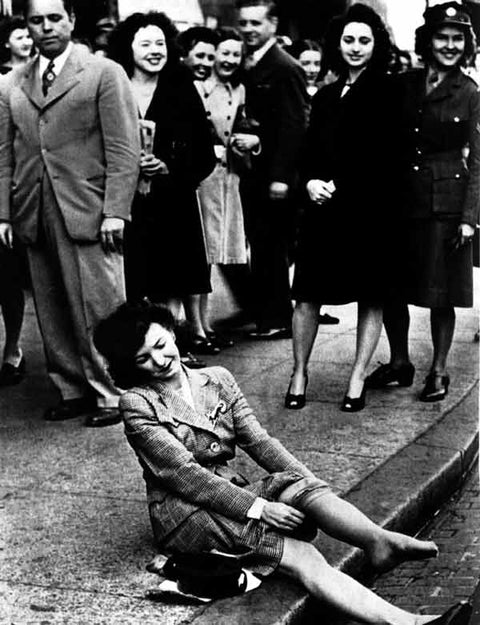We love each and every one of our stockists, but it puts a particular smile on our faces when they are clearly as geeky about lingerie as we are. German online retailer www.lyngerie.de is a purely web based lingerie retailer based in Germany, but they are no ordinary online shop; their mission statement is to offer the finest vintage inspired lingerie ranges to their customers, stocking mainly small, independent brands. We approve!
One of the things Lyngerie.de pride themselves on is the quality of their information, and their excellent ‘Lingerie-Wiki’ is a wonderful resource for lingerie enthusiasts (though sadly not available in English) – a lexicon of terms explained in detail, from ‘Accessoir’ to ‘Wonderbra’! (I was trying think to think of a ‘Wunderbar’ pun for this but it’s too early in the day). Click the below link to see the lingerie wiki for yourself.
http://www.lyngerie.de/dessous/lexikon.php
They also wrote this excellent article on the history of stockings, which is full of fun facts and nerdy knowledge. Did you know that Fully Fashioned stockings are still made today on the same machines as they were in the 1940s? No? Well you do now! Read on to discover the almost-vanished world of stocking production and manufacture.*
The starting material: 100% Nylon
In the mid-thirties, Dr. Wallace Hume Carothers invented nylon as a raw material which would pave the way for the industrial mass production of yarn and stockings. (Unfortunately the brilliant chemist did not live to see the triumph of his invention, as he took his own life in 1937.)
One of the most striking features of these classic nylons is something that only a handful of companies, who are in possession of the original machines today, are able to produce; the starting material, nylon line. This ultra-thin yarn is produced by the polyamide-spinning solution being forced through a spinneret. The viscous thread at the output of these nozzles gets stuck at high temperatures, with regulated air flow thinning and stretching it.
The resulting ultra-thin nylon thread cannot pull in length. It is this characteristic which results in the back seam and the typical characteristics of the nylon stocking such as the formation of wrinkles and the "rattling" handle. (Modern stockings, however, are stretchy due to the additional use of spandex, and fit like a second skin on the leg.)

The creation of the stocking

Production of the original seamed stockings on the ‘Cotton machine’ was developed in its basic form by William Cotton in England in 1864.
The German manufacturer Hermann Stärker further developed this technology with the Einfadenwirkwaren-Maschin (a thread hosiery machine). On these machines up to 36 stockings could be made at the same time.
With up to 9 needles per centimetre, the motion of the needle bar pulled the pointed needles through the preformed loops. With up to 400 needles these old machines could produce 100 ‘stitches’ in a minute. This resulted in a flat, shaped nylon fabric, the needles having different widths to ensure the fit of the stocking.
The next step in the production was to sew the nylons. This work is still done by hand and a seamstress must be very skilled to make these seams neatly. The classic triple seam (also called stocking eye) is always at the stocking top (the reinforced toe area) and runs right up to the hole in the welt. Thus, the seam runs on the sole area. (There are also seamed stockings with a seam at the front leg which are today among the absolute rarities.)
The "real" ff stockings which are prepared by this method are recognisable to the trained eye by the small dots to about 10mm on the right and left of the seam – the so-called ‘reduction pattern’.
In addition to the toe and the welt, the area likely to wear most heavily (the heel) is also reinforced. From this sprang various fashions. Today's most famous high heel forms are the Point Heel (pointed to the seam heel) and the Cuban Heel (square heel).
The welt is also made of reinforced material and sewn twice, so it is more stable and can absorb the tensile forces of the garter. Due to the "inflexibility" of real nylon stockings these tensile forces are not to be underestimated. These occur with every move because the nylon stocking does not stretch. Therefore, it is important to choose the appropriate garter girdle when wearing ff stockings. This should not slip at the waist and be better equipped with six instead of four suspenders so the seam does not slip.
Real nylons vs. modern Stockings

Admittedly, it must be said that modern stockings or tights have the addition of elastane for a better fit and greater comfort. Also the non-stretchy nylon stocking is more suited to the "standard leg" – for women with a larger build, there will always be problems with the fit of real nylons. In general, these are there too tight on the thighs. The same is with very slim, tall women, on whom classic nylons will be prone to wrinkles.
And yet the demand for these stockings is unbroken. This is not only for nostalgic value or fans of vintage. The real backseam still exudes a touch of eroticism and feminine sensuality.
Due to the fairly elaborate production, which is still as expensive as the maintenance of the original Cotton machines, the prices for some real nylon stockings with seam have risen to around the 30 euro mark. Manufacturers like Gerbe (Paris) are already charging more than that. Alternatives to the FF stocking with back seam have emerged, where the back seam is purely ornamental. From Cervin, for example, real nylon stockings (ie 100% nylon yarn and non-stretchy) are offered with stylized seam, which should reflect the look and feel of the 50s.
One thing is certain, the genuine ff stockings will stay around for at least few more years...
...and that's a good thing.
*I painstakingly translated all that from German (well, from Google Translate's version of German to English, which is not far off being in another language), so any inaccuracies or things lost in translation, do let me know!


